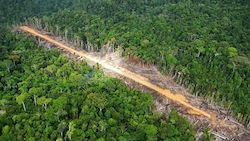Anti-narcotics agents report finding more than 1,000 clandestine landing strips in Bolivia over the past three years, illustrating the country’s important role in the regional flow of illegal drugs destined largely for the market in Europe.
The commander of Bolivia’s special anti-narcotic force (Fuerza Especial de Lucha Contra el Narcotráfico – FELCN) told La Razón the “narco-strips” found along the country’s borders with Peru and Brazil are used by drug traffickers to fly in drugs from the Apurímac, Ene and Mantaro River Valleys (VRAEM) — Peru’s center for coca production. He said 10 new strips have been located this year.
This Peru-Bolivia air bridge has created a drug boom in the area, as evidenced by the high number of clandestine landing strips being identified. In 2013, Bolivian Defense officials said aerial reconnaissance identified 70 landing strips near the country’s border with Peru, Datos reported. Despite Bolivian authorities’ ongoing efforts to find and destroy strips, the numbers have continued to rise in recent years.
A FELCN study indicated that since the establishment of the air bridge in 2007 drug trafficking has increased annually. The study, reported in La Razón’s print edition, attributed increased use of the air bridge to drug traffickers’ efforts to meet demand for cocaine in the European market via Brazil. Some of that traffic reportedly hits Africa on its way.
In May 2016, Bolivia and Peru signed an anti-drug agreement in Copacabana, Bolivia, outlining joint plans to cooperate in the fight against drug trafficking in the area. The air bridge between them is a specific target of the accord. So far, Bolivia and Peru have conducted seven joint operations aimed at eliminating the drug traffickers’ air bridge, La Razón reported, and agents from Brazil are expected to take part in additional operations this year.
InSight Crime Analysis
Bolivia’s geographic location — bordering five other South American countries — makes it a strategic location for the drug trade. Apart from being the third largest cocaine producer in the world, Bolivia serves as an essential transit country for drugs produced in other South American countries. The 2016 International Narcotics Control Strategy report (pdf) states that 50 percent of all Peruvian cocaine “departs to or through Bolivia via aerial transshipment,” otherwise known as the air bridge.
SEE ALSO: Coverage of Bolivia
Bolivia has been trying to combat drug traffickers entering their airspace. In April 2014, the country passed legislation which allowed the Bolivian Air Space Security and Defense Command to shoot down “hostile” planes if they failed to respond to warnings. El Deber reported Bolivia acquired 14 radars from France for civil and military coverage in November 2015. Following the Copacabana agreement, the Bolivian vice-minister of Social Defense said that in 2016 alone they confiscated 35 drug planes. He added that two Bolivian drug planes were shot down over Peruvian territory.
According to Sabino Mendoza, a leading Bolivian anti-drug official, Bolivia is currently undertaking a strategy that is set to finish in 2017. Mendoza believes that, with the combination of the legislation to shoot down hostile planes and the “implementation of technology,” they will be able in “some ways to address this issue.”
The example of Colombia suggests that reducing the amount of air trafficking is possible. By 2014, the number of such flights being detected over Colombia had reportedly dropped by 99 percent from a decade earlier. Some attribute Colombia’s success to the country’s intensive aerial interdiction program, and point at Bolivia’s delay in adopting radar technology as a big factor contributing to the emergence of the Peru-Bolivia air bridge.

